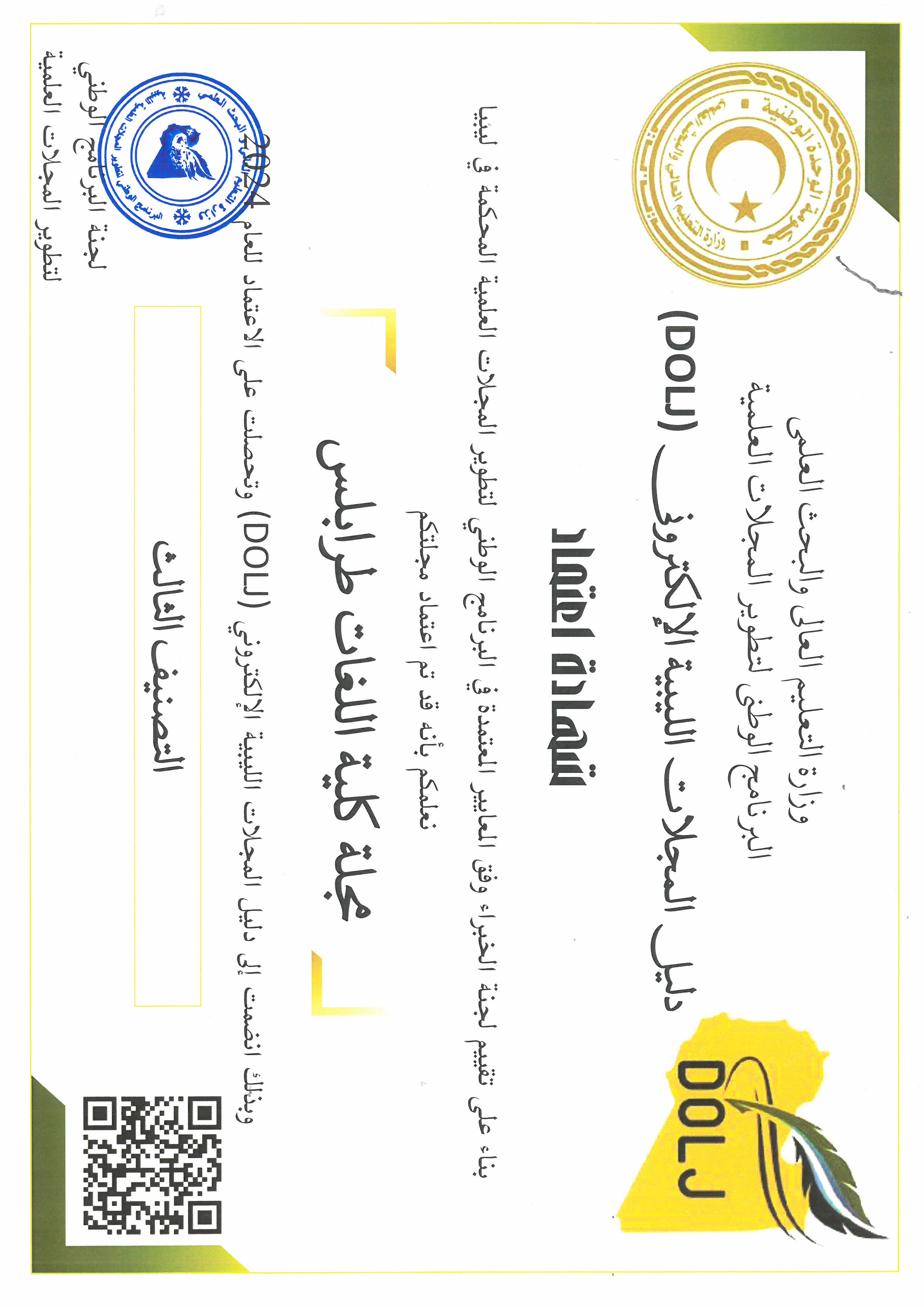Libyan Teens in Cyberspace: A Study of Computer-Mediated Discourse
الكلمات المفتاحية:
cyber language, text messages, SMS, discourse analysisالملخص
This paper investigates some linguistic, social and cultural features of the newly practiced variety of cyber language dialect used by Libyan ado-lescents to shorten electronic communications through mobile phones, e-mails and computers. The study also explores the influence of using the cyber language dialect on the Libyan youngsters’ language and interac-tion skills online and via texting. Cyber language is used through social media, and the other means of texting involving SMS (short-messaging services). The study utilized discourse analysis of some collected texts from social media, mainly Facebook as used by Libyan young people. The present research study is qualitative and the data collected includes English linguistic chunks of cyber language with some Arabic letters, emojis symbols and emoticons used by 20 Libyan adolescent speakers as a creative way to convey, enhance, and support everyday life com-munication between them. The findings showed that Libyan interlocu-tors create a set of nonstandard linguistic form to interact and communi-cate effectively using cyber language
المراجع
Altohami, W. M. (2020). Text Messages: A Computer-mediated Discourse Analysis. International Journal of Advanced Computer Science and Applications, 11.
Baron, N. S. (2008). Always on - Language in an online and mobile world. New York: Oxford University Press.
Baruah, T.D., Kanta, K., & State, H. (2012). Effectiveness of Social Media as a tool of communication and its potential for technology enabled connections: A micro-level study. International Journal of Scientific and Research Publications, 2, 1-10.
Cherny, L. (1999). Conversation and community: Chat in a virtual world. Stanford, California: CSLI Publications.
Christopherson, L. (2010). What are people really saying in World of Warcraft® chat? Proceedings of the American Society for Information Science and Technology, 47(1), 1-2.
Christopherson, L. (2011). Can u help me plz?? Cyberlanguage accommodation in virtual reference conversations. ASIS&T Annual Meeting.
Collister, L. B. (2008, April 29). Virtual discourse structure: An analysis of conversation in World of Warcraft. Pennsylvania: University of Pittsburgh.
Crystal, D. (2001). Language and the Internet. Cambridge. Cambridge University Press
Crystal, D. (2006). Language and the Internet. Cambridge. Cambridge University Press.
Crystal, D. (2008). Txting: the gr8 db8. New York: Oxford University Press.
December, J. (1996). Units of analysis for Internet communication. Journal of Computer-mediated Communication, 1(4).
Eid, G. (2004). Libya: The Internet in a conflict zone,”. The Arabic Network for Human Rights Information. Retrieved from http://www.anhri.net/en/reports/net2004/libya.shtml.
Ethelb, H. (2016). The People or the Police: Who to Blame? A Study Investigating Linguistic and Textual Devices Journalists Use in Framing News Stories. Theory and Practice in Language Studies, 6, 2245-2253.
Ethelb, H. (2019). Changing the Structure of Paragraphs and Texts in Arabic: A Case from News Reporting. International Journal of Comparative Literature and Translation Studies, 7:(3), 8-25.
Freiermuth, M. R. (2002). Online chatting: An alternative approach to simulations. Simulation & Gaming, 32, 187-195.
Freudenberg, K. (2009). Investigating the impact of SMS speak on the written work of English first language and English second language high school learners [Master's Degree, Stellenbosch University]. South Africa.
Gee, J. (1999). Introduction to Discourse Analysis: Theory and Method. (2nd Ed.). New York: Routledge.
Goggin, G. (2005). Mobile phone culture and the love of text messaging [Conference Presentation]. the Annual Meeting of the Australian and New Zealand Communication Association. Christchurch, New Zealand.
González‐Lloret, M. (2011). Conversation Analysis of Computer-Mediated Communication. The CALICO Journal, 28, 308-325.
Grinter, R. E. & Eldridge, M. A., (2001). y do tngrs luv 2 txt msg?. In Proceedings of the seventh European Conference on Computer Supported Cooperative Work (ECSCW) Bonn, Germany, 219- 238. Dordrecht, Netherlands: Kluwer Academic Publishers.
Herring, S. C. (2001). Computer-mediated discourse. In D. Tannen, D. Schiffrin, H. Hamilton (Eds.) Handbook of discourse analysis (pp. 612-634). Oxford: Blackwell Publishers.
Herring, S. C. (2004). Computer-mediated discourse analysis: An approach to researching online behavior. In S. A. Barab, R. Kling, J.H. Gray (Eds.). Designing for virtual communities in the service of learning (pp. 338-376). New York: Cambridge University Press.
McNeil, R. (2008). Do you speak American? [Web DVD]. A MacNeil/Lehrer Palladin/Invision Production, Thirteen/ WENT. New York & KLRU, Austin, Texas.
Nardi, B. A., Whittaker, S., & Bradner, E. (2000). Interaction and outeraction: instant messaging in action. Proceedings of the 2000 ACM conference on Computer supported cooperative work, 79-88. Philadelphia, Pennsylvania, United States: ACM.
Naveed, A., & Aziz, S. (2014). Analysis of Cyber Language: Identifying Gender Boundaries. European Academic Research, 2(7).
Shortis, T. (2001). The language of ICT: Information and communication technology. London: Routledge
Smith, J.H. (2006). Avatars you can trust - A survey on the issue of trust and communication in MMORPGs. Retrieved from http://gameresearch.com/index.php/articles/avatars-you-can-trust-asurvey-on-the-issue-of-trust-and-communication-inmmorpgs/
Sykes, J. M. (2005). Synchronous CMC and pragmatic development: Effects of oral and written chat, CALICO Journal, 22(3), 399-431.
Tagg, C. (2009). A corpus linguistic study of SMS text messaging [Doctoral Dissertation, University of Birmingham]. The United Kingdom.
Thorne, S. L. (2006). Pedagogical and praxiological lessons from internet-mediated intercultural foreign language education research. In J. A. Belz & S. Thorne (Eds.). Internet-mediated intercultural foreign language education, (pp. 2-30). Boston: Heinle and Heinle
Tudini, V. (2003). Using native speakers in chat. Language Learning & Technology, 7(3), 141-159. Retrieved from http://llt.msu.edu/vol7num3/tudini/default.ht
Werry, C. (1996). Linguistic and interactional features of Internet Relay Chat. In S. C. Herring (Ed.). Computer-mediated communication: Linguistic, social and crosscultural perspectives, (pp. 47-63). Amsterdam: J. Benjamins.

التنزيلات
منشور
كيفية الاقتباس
إصدار
القسم
الرخصة
الحقوق الفكرية (c) 2025 Faculty of Languages Journal-Tripoli-Libya

هذا العمل مرخص بموجب Creative Commons Attribution 4.0 International License.
 https://orcid.org/0009-0002-8251-5878
https://orcid.org/0009-0002-8251-5878




